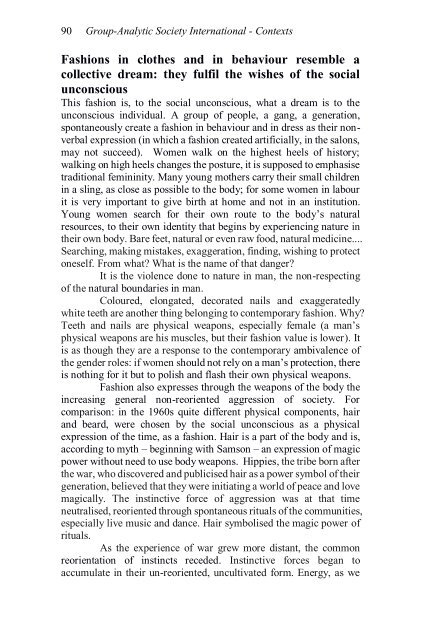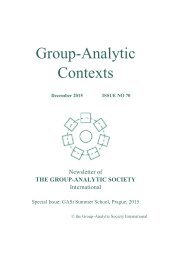Group Analytic Contexts, Issue 77, September 2017
Newsletter of the Group Analytic Society International
Newsletter of the Group Analytic Society International
Create successful ePaper yourself
Turn your PDF publications into a flip-book with our unique Google optimized e-Paper software.
90 <strong>Group</strong>-<strong>Analytic</strong> Society International - <strong>Contexts</strong><br />
Fashions in clothes and in behaviour resemble a<br />
collective dream: they fulfil the wishes of the social<br />
unconscious<br />
This fashion is, to the social unconscious, what a dream is to the<br />
unconscious individual. A group of people, a gang, a generation,<br />
spontaneously create a fashion in behaviour and in dress as their nonverbal<br />
expression (in which a fashion created artificially, in the salons,<br />
may not succeed). Women walk on the highest heels of history;<br />
walking on high heels changes the posture, it is supposed to emphasise<br />
traditional femininity. Many young mothers carry their small children<br />
in a sling, as close as possible to the body; for some women in labour<br />
it is very important to give birth at home and not in an institution.<br />
Young women search for their own route to the body’s natural<br />
resources, to their own identity that begins by experiencing nature in<br />
their own body. Bare feet, natural or even raw food, natural medicine....<br />
Searching, making mistakes, exaggeration, finding, wishing to protect<br />
oneself. From what? What is the name of that danger?<br />
It is the violence done to nature in man, the non-respecting<br />
of the natural boundaries in man.<br />
Coloured, elongated, decorated nails and exaggeratedly<br />
white teeth are another thing belonging to contemporary fashion. Why?<br />
Teeth and nails are physical weapons, especially female (a man’s<br />
physical weapons are his muscles, but their fashion value is lower). It<br />
is as though they are a response to the contemporary ambivalence of<br />
the gender roles: if women should not rely on a man’s protection, there<br />
is nothing for it but to polish and flash their own physical weapons.<br />
Fashion also expresses through the weapons of the body the<br />
increasing general non-reoriented aggression of society. For<br />
comparison: in the 1960s quite different physical components, hair<br />
and beard, were chosen by the social unconscious as a physical<br />
expression of the time, as a fashion. Hair is a part of the body and is,<br />
according to myth – beginning with Samson – an expression of magic<br />
power without need to use body weapons. Hippies, the tribe born after<br />
the war, who discovered and publicised hair as a power symbol of their<br />
generation, believed that they were initiating a world of peace and love<br />
magically. The instinctive force of aggression was at that time<br />
neutralised, reoriented through spontaneous rituals of the communities,<br />
especially live music and dance. Hair symbolised the magic power of<br />
rituals.<br />
As the experience of war grew more distant, the common<br />
reorientation of instincts receded. Instinctive forces began to<br />
accumulate in their un-reoriented, uncultivated form. Energy, as we













